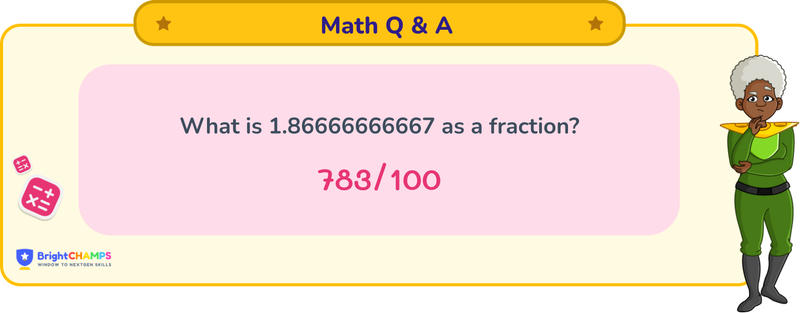
 222 Learners
222 LearnersLast updated on August 5, 2025

1.86666666667 as a Fraction

Numbers can be categorized into different types. Fraction is one of its kind. It is always represented in the form of p/q, where p is the numerator and q is the denominator. Fractions represent a whole and a fractional part. Decimals represent the fractional part of numbers. For example, 1/2, the numbers in decimal are expressed with a decimal point (.), For example, 1.86666666667, we are going to learn how to convert a decimal to a fraction.
What is 1.86666666667 as a Fraction?
 Answer
Answer
The answer for 1.86666666667 as a fraction will be 28/15.
Explanation
Converting a decimal to a fraction involves a few steps. You can follow the steps mentioned below to find the answer.
Step 1: Identify the repeating part of the decimal. In 1.86666666667, the repeating part is 6.
Step 2: Let x = 1.86666666667. Multiply by 10 to shift the decimal point: 10x = 18.6666666667.
Step 3: Multiply by another 10 to move past the repeating part: 100x = 186.6666666667.
Step 4: Subtract the first equation from the second to eliminate the repeating decimal: 100x - 10x = 186.6666666667 - 18.6666666667 90x = 168 x = 168/90
Step 5: Simplify the fraction by dividing both the numerator and the denominator by their GCD, which is 6: 168/90 = 28/15
Thus, 1.86666666667 can be written as a fraction 28/15.
Important Glossaries for 1.86666666667 as a Fraction
- Fraction: A numerical quantity that is not a whole number, representing a part of a whole.
- Decimal: A number that uses the base ten and includes a decimal point to separate the whole part from the fractional part.
- Repeating Decimal: A decimal in which a digit or group of digits repeats infinitely.
- Numerator: The top part of a fraction, indicating how many parts of the whole are being considered.
- Denominator: The bottom part of a fraction, showing how many parts make up a whole.




